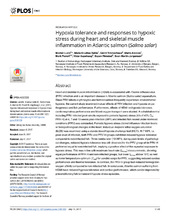Hypoxia tolerance and responses to hypoxic stress during heart and skeletal muscle inflammation in Atlantic salmon (Salmo salar)
Lund, Morten; Dahle, Maria Krudtaa; Timmerhaus, Gerrit; Alarcon, Marta; Powell, Mark; Aspehaug, Vidar; Rimstad, Espen; Jørgensen, Sven Martin
Peer reviewed, Journal article
Published version

Åpne
Permanent lenke
https://hdl.handle.net/1956/17010Utgivelsesdato
2017-07-11Metadata
Vis full innførselSamlinger
Originalversjon
https://doi.org/10.1371/journal.pone.0181109Sammendrag
Heart and skeletal muscle inflammation (HSMI) is associated with Piscine orthoreovirus (PRV) infection and is an important disease in Atlantic salmon (Salmo salar) aquaculture. Since PRV infects erythrocytes and farmed salmon frequently experience environmental hypoxia, the current study examined mutual effects of PRV infection and hypoxia on pathogenesis and fish performance. Furthermore, effects of HSMI on hypoxia tolerance, cardiorespiratory performance and blood oxygen transport were studied. A cohabitation trial including PRV-infected post-smolts exposed to periodic hypoxic stress (4 h of 40% O2; PRV-H) at 4, 7 and 10 weeks post-infection (WPI) and infected fish reared under normoxic conditions (PRV) was conducted. Periodic hypoxic stress did not influence infection levels or histopathological changes in the heart. Individual incipient lethal oxygen saturation (ILOS) was examined using a standardized hypoxia challenge test (HCT). At 7 WPI, i.e. peak level of infection, both PRV and PRV-H groups exhibited reduced hypoxia tolerance compared to non-infected fish. Three weeks later (10 WPI), during peak levels of pathological changes, reduced hypoxia tolerance was still observed for the PRV group while PRV-H performed equal to non-infected fish, implying a positive effect of the repeated exposure to hypoxic stress. This was in line with maximum heart rate (fHmax) measurements, showing equal performance of PRV-H and non-infected groups, but lower fHmax above 19°C as well as lower temperature optimum (Topt) for aerobic scope for PRV, suggesting reduced cardiac performance and thermal tolerance. In contrast, the PRV-H group had reduced hemoglobin-oxygen affinity compared to non-infected fish. In conclusion, Atlantic salmon suffering from HSMI have reduced hypoxia tolerance and cardiac performance, which can be improved by preconditioning fish to transient hypoxic stress episodes.
